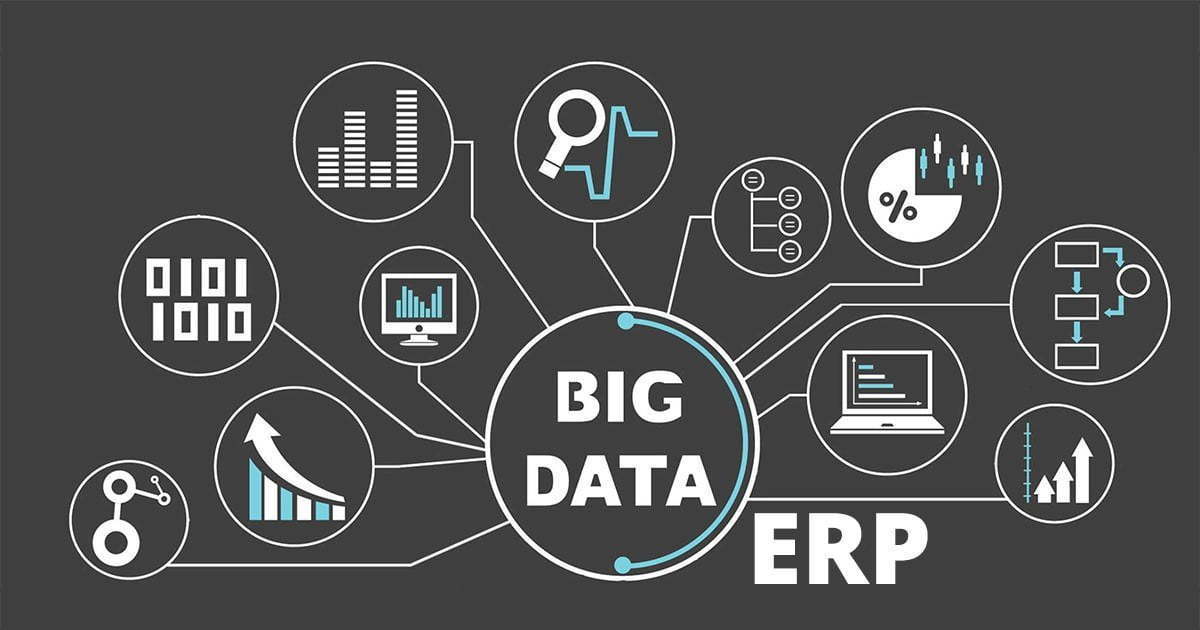Analytics in Revolutionizing Resource Planning with Big Data and ERP.
 Glasier Inc.
Glasier Inc.
Introduction
Welcome to the era where data isn't just a pile of numbers but the cornerstone of strategic planning. Integrating analytics with Big Data and ERP (Enterprise Resource Planning) systems is akin to giving businesses a crystal ball. ERP software trends, This powerful combination is revolutionizing resource planning, streamlining operations, and paving the way for unprecedented levels of efficiency. Together, they're enabling organizations to make informed, data-driven decisions faster than ever before. Dive into how this integration is transforming the landscape of business planning and operations.
Revolutionizing Resource Planning with Big Data and ERP
Understanding Big Data and ERP Systems
Big Data and Enterprise Resource Planning (ERP) systems are like the power couple of the business world. Big Data refers to the vast volumes of data generated from various sources, including social media, transaction records, and Internet of Things (IoT) devices. It's so massive and complex that traditional data processing software can barely handle it. On the flip side, ERP systems are all about helping organizations manage and integrate their core business processes in one go. These systems streamline workflows, improve efficiencies, and ensure that different sections of a business are on the same page. When you bring Big Data and ERP systems together, you unlock a whole new level of data management and insight generation. This duo essentially empowers businesses to make more informed decisions by leveraging comprehensive data analysis.
The Potential of Analytics in Resource Planning
Integrating analytics into resource planning through Big Data and ERP systems is a game changer. This trio allows businesses to dive deep into their operations, identifying patterns and trends that were previously invisible. For instance, through predictive analytics, a company can forecast future demands accurately, ensuring they're always a step ahead. Similarly, descriptive analytics can provide insights into how different factors are impacting business performance. By leveraging these analytics capabilities, businesses can optimize their resource allocation, improve their service delivery, and ultimately enhance customer satisfaction. The beauty of this approach lies in its ability to transform raw data into actionable insights, leading to smarter, data-driven decisions.
The Role of Analytics in Driving Efficiency
Real-time Data Analysis for Better Decision Making
One of the most dynamic aspects of integrating analytics with Big Data and ERP systems is the capability for real-time data analysis. Imagine being able to monitor your business operations as they happen and making instantaneous decisions based on current data. This real-time approach enables businesses to respond swiftly to unexpected changes in demand or supply chain disruptions. Furthermore, it allows managers to identify and address inefficiencies in their processes immediately, reducing downtime and waste. Real-time data analysis transforms the way businesses operate, making them more agile and responsive to market changes.
Predictive Analytics for Resource Optimization
Predictive analytics takes the power of Big Data and ERP systems to a whole new level by offering insights into what might happen in the future. This type of analytics uses historical data, statistical algorithms, and machine learning techniques to identify the likelihood of future outcomes. For businesses, this means being able to anticipate customer demands, manage inventory levels efficiently, and even predict maintenance needs for equipment. By knowing what's likely to come, companies can proactively plan their resources, ensuring they are used in the most effective and efficient manner possible. This proactive approach not only saves time and money but also significantly reduces the risk of overproduction, stockouts, and unplanned downtime.
In summary, the integration of analytics with Big Data and ERP systems is fundamentally reshaping the landscape of resource planning. By embracing these technologies, businesses can enjoy enhanced decision-making capabilities, improved operational efficiency, and a competitive edge in today’s data-driven world.
Leveraging Big Data Analytics for Data-driven Decision Making
Big Data analytics has become a game-changer in how organizations approach decision-making, especially in resource planning. By analyzing large sets of data, businesses can uncover hidden patterns, market trends, and customer preferences, which were previously untapped due to the sheer volume and complexity of the data. This shift towards data-driven decision-making empowers companies to make more informed and strategic decisions.
Identifying Trends and Patterns in Resource Planning
One of the key benefits of integrating Big Data analytics into resource planning is the ability to identify trends and patterns that impact resource allocation. For instance, by analyzing sales data, social media trends, and market conditions, organizations can predict future product demand more accurately. This foresight enables businesses to adjust their inventory levels, optimize staffing, and better manage their supply chain, minimizing waste and maximizing efficiency.
Improving Forecasting and Demand Planning
Big Data analytics significantly enhances forecasting and demand planning processes. Traditional methods relied on historical data and linear forecasting models, which often failed to account for the complexities and rapid changes in today’s market. Big Data analytics, however, can process and analyze vast amounts of data in real-time, incorporating variables such as seasonal shifts, geopolitical events, and emerging market trends. This level of granularity not only improves the accuracy of forecasts but also allows for more agile and responsive planning strategies.
Enhancing Supply Chain Management
In the realm of supply chain management, Big Data analytics offers transformative insights that can lead to substantial efficiencies and cost savings. By tracking and analyzing data across the entire supply chain, from raw materials sourcing to last-mile delivery, businesses can identify bottlenecks, predict potential disruptions, and optimize routes and logistics. This holistic view of the supply chain helps companies to be more proactive, reducing delays and improving customer satisfaction.
Challenges and Considerations in Implementing Analytics in Resource Planning
While the potential benefits of Big Data analytics in resource planning are vast, organizations also need to navigate a range of challenges and considerations to fully leverage these technologies.
Data Integration and Data Quality
One of the primary challenges in implementing analytics for resource planning is integrating disparate data sources and ensuring the quality of the data. Many organizations have data siloed across different departments and systems, which can be difficult to consolidate. Moreover, the usefulness of analytics is directly tied to the quality of the data analyzed. Therefore, companies must invest in robust data integration solutions and implement stringent data quality management practices to fully benefit from analytics.
Security and Privacy Concerns
As with any technology that handles vast amounts of data, security and privacy are significant concerns. Big Data analytics involves processing sensitive and proprietary information, which can be a target for cyberattacks. Organizations must prioritize securing their data analytics infrastructure, implementing strong data governance policies, and ensuring compliance with relevant data protection regulations.
Skills and Expertise Required
Finally, leveraging Big Data analytics in resource planning requires a specific set of skills and expertise. Data scientists, analytics experts, and IT professionals who understand both the technical and strategic aspects of Big Data are essential for harnessing its full potential. Businesses may need to invest in training current staff, hiring new talent, or partnering with specialized ERP software development companies or Hire SaaS developers to fill these skills gaps.
In conclusion, while integrating Big Data analytics into resource planning offers significant opportunities for transformation and efficiency gains, organizations must thoughtfully address the challenges and considerations to successfully navigate this complex landscape.
The Future of Analytics in Resource Planning
The future of analytics in resource planning is incredibly exciting, marked by groundbreaking advancements and the integration of innovative technologies. As we navigate this future, we're seeing two major trends taking the lead the application of artificial intelligence and machine learning, and the use of advanced analytics for predictive insights. These developments are not just transforming how businesses strategize and operate but are also setting new standards for efficiency and data-driven decision-making.
Artificial Intelligence and Machine Learning in Resource Planning
Artificial Intelligence (AI) and Machine Learning (ML) are revolutionizing the landscape of resource planning. These technologies offer the ability to process huge volumes of data at an unprecedented speed, providing insights that were previously unimaginable. From optimizing inventory levels to predicting workforce requirements, AI and ML are making resource planning more accurate and responsive. By automating routine tasks, these technologies allow professionals to focus on more strategic aspects of resource management, leading to significant time and cost savings. Moreover, AI and ML can continuously learn from data patterns, ensuring that resource planning becomes more refined and effective over time.
Advanced Analytics for Predictive Insights
Another key aspect of the future of analytics in resource planning is the use of advanced analytics for predictive insights. This approach involves analyzing current and historical data to forecast future trends, demands, and issues. By identifying potential problems before they occur, businesses can make proactive adjustments to their resource planning strategies, thus avoiding costly overages or shortages. Advanced analytics tools can reveal patterns and correlations that human analysis might miss, empowering companies to make informed decisions grounded in data. This shift towards predictive planning is not just about avoiding pitfalls; it's also about seizing opportunities and optimizing operations in ways that were not possible before.
Conclusion
In the rapidly evolving world of business, integrating analytics with Big Data and ERP systems has become more than a trend—it's a transformational movement. By enabling more efficient resource planning and fostering an environment of data-driven decision-making, businesses are not only staying afloat but thriving in competitive environments. The collaboration of Big Data, analytics, and ERP is not just reshaping how organizations operate; it's setting a new standard for operational excellence. As we continue to navigate through the realms of digital innovation, this trio will undoubtedly play pivotal roles in driving businesses forward, making now the perfect time to adapt, adopt, and excel.
At Glasier Inc, we recognize the transformative power of integrating analytics with Big Data and ERP systems. Our expertise in leveraging these technologies enables us to empower businesses with actionable insights and streamlined processes. By partnering with us, businesses can harness the full potential of data-driven decision-making and achieve operational excellence in today's dynamic business landscape.
Subscribe to my newsletter
Read articles from Glasier Inc. directly inside your inbox. Subscribe to the newsletter, and don't miss out.
Written by

Glasier Inc.
Glasier Inc.
Our Glasierinc is a renowned hybrid app development company providing custom hybrid application development services to businesses or startups, Glasierinc can create hybrid mobile apps that combine native capabilities while employing the power of React Native, Flutter Apps. AngularJS, Node.JS.